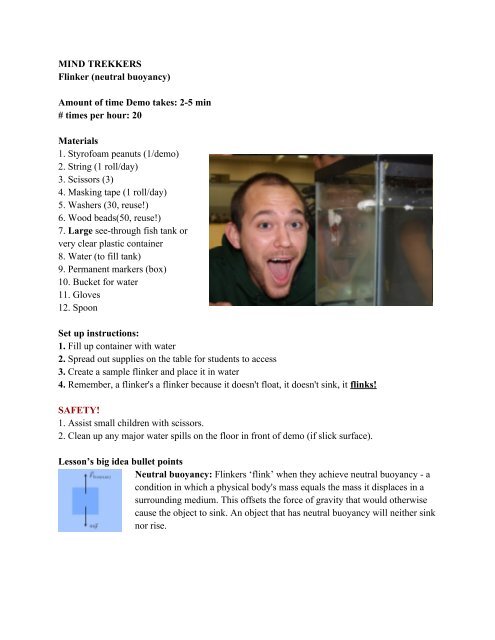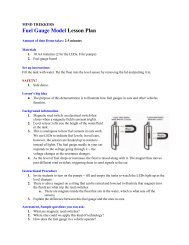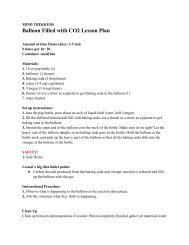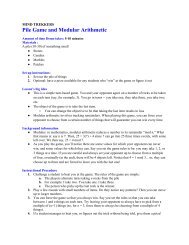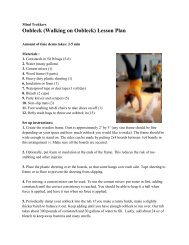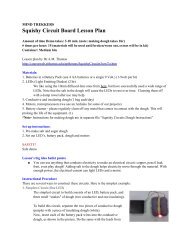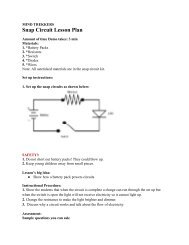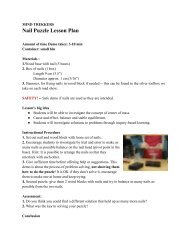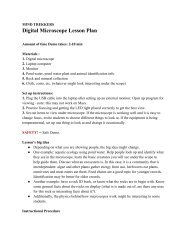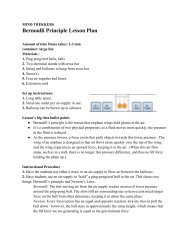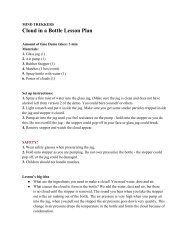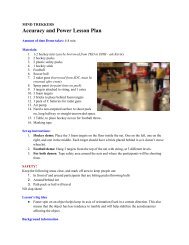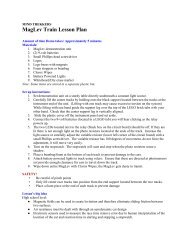Flinker - MTU Mind Trekkers
Flinker - MTU Mind Trekkers
Flinker - MTU Mind Trekkers
You also want an ePaper? Increase the reach of your titles
YUMPU automatically turns print PDFs into web optimized ePapers that Google loves.
MIND TREKKERS<br />
<strong>Flinker</strong> (neutral buoyancy)<br />
Amount of time Demo takes: 2-5 min<br />
# times per hour: 20<br />
Materials<br />
1. Styrofoam peanuts (1/demo)<br />
2. String (1 roll/day)<br />
3. Scissors (3)<br />
4. Masking tape (1 roll/day)<br />
5. Washers (30, reuse!)<br />
6. Wood beads(50, reuse!)<br />
7. Large see-through fish tank or<br />
very clear plastic container<br />
8. Water (to fill tank)<br />
9. Permanent markers (box)<br />
10. Bucket for water<br />
11. Gloves<br />
12. Spoon<br />
Set up instructions:<br />
1. Fill up container with water<br />
2. Spread out supplies on the table for students to access<br />
3. Create a sample flinker and place it in water<br />
4. Remember, a flinker's a flinker because it doesn't float, it doesn't sink, it flinks!<br />
SAFETY!<br />
1. Assist small children with scissors.<br />
2. Clean up any major water spills on the floor in front of demo (if slick surface).<br />
Lesson’s big idea bullet points<br />
Neutral buoyancy: <strong>Flinker</strong>s ‘flink’ when they achieve neutral buoyancy - a<br />
condition in which a physical body's mass equals the mass it displaces in a<br />
surrounding medium. This offsets the force of gravity that would otherwise<br />
cause the object to sink. An object that has neutral buoyancy will neither sink<br />
nor rise.
Instructional Procedure<br />
1. When students arrive ASK: “Can you make a "flinker" - something that you put in a pitcher<br />
of water that doesn't float on the top or sink to the bottom, but just flinks in the middle of the<br />
water”<br />
2. Tell them, “Your flinker should flink for 10 seconds.”<br />
3. Encourage students to design their own flinker using styrofoam peanuts, string and<br />
washers or wood beads. Allow students to customize their flinker by giving it a face with the<br />
permanent markers.<br />
4. Once the flinker is finished tell the students to test it in the water.<br />
5. If the flinker doesn’t “flink” encourage students to change one thing at a time in their design<br />
until their flinker “flinks.” ASK: “What can you change to make it flink Could you attach<br />
washers or wood beads to your Styrofoam peanut with string Or, could you change the shape of<br />
the Styrofoam”<br />
6. Try to get flinkers to flink for 10+ seconds.<br />
7. If multiple students are around, hold a competition to see whose flinker can flink the longest.<br />
Clean Up<br />
1. Discard used flinkers; collect washers and wood beads for reuse.<br />
2. Make sure all permanent markers are accounted for and returned to container or banded<br />
together.<br />
3. Discard the water and wipe out the container.<br />
4. When completely finished gather all materials listed for this demonstration and make sure<br />
everything is accounted for. If something was used up, broken or damaged, let someone know so<br />
it can get replaced or fixed.<br />
References:<br />
http://pbskids.org/zoom/activities/sci/flinker.html<br />
National Standards<br />
K-4 Content Standard B: Physical Science, Properties of objects and materials<br />
5-8 Content Standard B: Physical Science, Properties and changes of properties in matter<br />
9-12 Content Standard B: Physical Science, Structures and properties of matter, interactions between<br />
energy and matter


